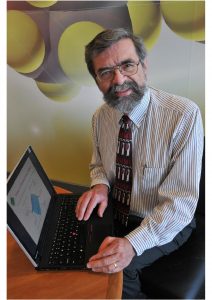Prof. Berny Schlegel (Wayne State University, Detroit USA)
Computational simulation of molecules interacting with intense laser fields
címmel tart előadást, amelynek helyszíne a BME CH 308 terme. Időpont: 2017. szeptember 8. 10.00 óra.
Az előadás összefoglalója:
Bernhard Schlegel
Department of Chemistry, Wayne State University, Detroit, Michigan 48202, USA
The availability of short, intense laser pulses  has opened up new frontiers in chemistry and physics. Attosecond laser pulses can directly explore electron dynamics, image molecular orbitals and probe bond making and breaking processes. Intense femtosecond laser pulses can act as photonic reagents by selectively altering the nuclear and electronic dynamics of molecules. The response of molecules to short, intense laser pulses cannot be treated by the perturbative methods used for ordinary spectroscopy. Direct simulation of the dynamics is needed to understand the behaviour of molecules under these extreme conditions.
has opened up new frontiers in chemistry and physics. Attosecond laser pulses can directly explore electron dynamics, image molecular orbitals and probe bond making and breaking processes. Intense femtosecond laser pulses can act as photonic reagents by selectively altering the nuclear and electronic dynamics of molecules. The response of molecules to short, intense laser pulses cannot be treated by the perturbative methods used for ordinary spectroscopy. Direct simulation of the dynamics is needed to understand the behaviour of molecules under these extreme conditions.
Short, intense laser pulses in the optical range cause rapid ionization. We have used time-dependent configuration interaction with absorbing boundaries to simulate the ionization of N2, O2, CO2, formaldehyde, ethylene, butadiene and hexatriene. We find that strong field ionization rates depend markedly on the conjugation length of the molecule and the orientation of the molecule in the laser beam. The shapes of the ionization yield for linearly polarized light can be understood primarily in terms of the nodal structure of the highest occupied orbitals. Depending on the orbital energies, ionization from lower lying orbitals may also make significant contributions to the shapes. The shapes of the ionization yield for circularly polarized light can be readily explained in terms of the shapes for linearly polarized light.
In the mid IR range, short intense laser pulses can rapidly deposit substantial amounts of vibrational energy into specific parts of a molecule. Such highly energized molecules can undergo fast rearrangements and selective dissociations. We have used ab initio classical trajectory calculations in time-varying electric fields to examine the fragmentation of molecules in intense IR laser pulses. If the molecule can be aligned in the intense laser field, the simulations show selective dissociation of stronger bonds in CF3Br+ and C6H5I2+, and enhanced yield of higher energy HCl+ products in the fragmentation of formyl chloride cation, ClCHO+. For C2H3+, short intense laser pulses result in an appreciable amount of angular displacement of the three hydrogens relative to the C2 core for circularly polarized light, but only an insignificant amount for linearly polarized light.